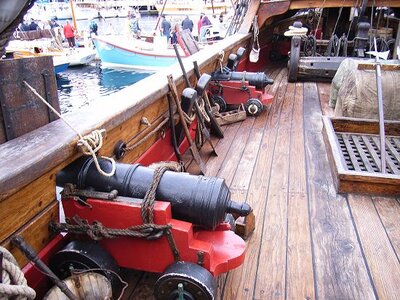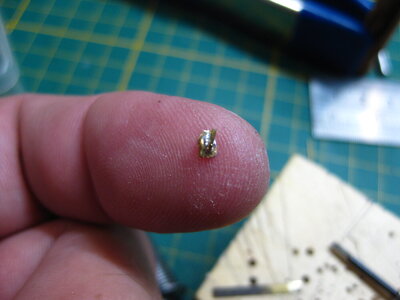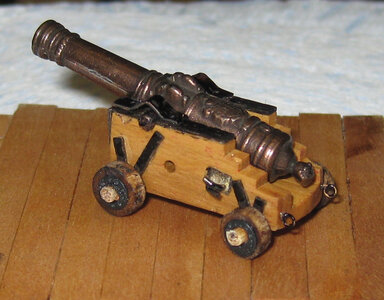-

Win a Free Custom Engraved Brass Coin!!!
As a way to introduce our brass coins to the community, we will raffle off a free coin during the month of August. Follow link ABOVE for instructions for entering.
You are using an out of date browser. It may not display this or other websites correctly.
You should upgrade or use an alternative browser.
You should upgrade or use an alternative browser.
VOC SPIEGELRETOURSCHIP BATAVIA 1628 - KOLDERSTOK 1:72
- Thread starter Heinrich
- Start date
- Watchers 64
-
- Tags
- batavia kolderstok
- Joined
- Aug 8, 2019
- Messages
- 5,484
- Points
- 738

Thanks Heinrich. When you look to your picture and the picture I posted of Ketting you can see a double hook on the side of the carriage. Dutch carriages got these to hook the tackles on. I even think there was no tackle to rol the cannon back. I think they use the same tackle to roll the cannon in or out, by just switshing the hook. and eye on the ship.
There is also no eye on the back of the cariage.
There is also no eye on the back of the cariage.
I have not been aware of a double hook before. One more for the brain box. Rich (PT-2)
Hi Steef66,I seen these solutions he made on the Duyfken. But if it is correct? I don’t believe so, but as you know they do not accept criticism on that platform so I don’t mentioned it there. But I believe, because I read a lot books and do a lot of study, that these ropes where not installed when the boats where in there place on the deck. Maybe on top of the cannon to the top of the gunports as an extra securing of the cannon like Peter (Pinguin) mentioned.
Herman Ketting showed them like this:
View attachment 256682 just like Harland below
Harland wrote: During sailing the guns on the upper decks where secured on the run out position "without the back tackles in place*". The longboats where placed on the deck and secured. This was also for the lifeboats the case, with just one difference that the boats where prepared for a quick hoisting out of the ship. In case of a man over board for example.
Source J. Harland Seamanship in the age of sail.
View attachment 256648Picture of Harland
* "without the back tackles in place" source: Mondfeld, Wolfram. Bayerlein, Anton. Klingenbrunn, Marietta. Schiffsgeschutze 1350 bis 1870
In this last source they also mentioning that the tackles hooked off while firing. To avoid that the cannon rolled over the tackles during recoil.
Ab Hoving recommend the book of Harland at a very high value, and I must say it is.
During battle a lot of preparing took place on board. On the main deck to lessen the change of loss, livestock and valuables were placed in the boats that where lowered over the ship side and where recovered later. The cannons where prepared for the battle and fully rigged to used them.
Source: The American Revolution 1775–1783: An Encyclopedia Volume 2
In another source I can't find back, it could be Steel, they drag the boats behind them on long lines, to keep them away from the battle. When they where on the deck, they could be shot to pieces. And get lost. Even the space they take on the deck is necessary during battle.
There is also a movie you must see. There is a good look on how things where going those days on these ships. I think the director of that movie did a lot of study too.It is the movie with Russel Crowe – Master and Commander.
Great description.
I am no expert on these things although I believe that another reason for the boats being lowered over the side while clearing for action was due to the amount of splinters created if a boat was hit by a cannon ball.
Cheers,
Stephen.
- Joined
- Jan 9, 2020
- Messages
- 10,534
- Points
- 938

@Stevedownunder You are right Stephen! There were basically two reasons for towing the lifeboats behind the mothership: obviously, if it was wrecked during a naval battle, it would reduce any survival chances in case of an actual shipwreck and secondly, flying splinters was a huge concern. In fact, it is widely believed that splinters caused more deaths and amputations than the actual cannon balls.
BUT ... we also have to make a distinction between two types of smaller boats that were normally part of a journey. There was the larger one which could accommodate a mast and sails and then the smaller "chaloup" like the one I have built. The larger one was always towed behind the ship while the smaller one was accommodated on deck.
BUT ... we also have to make a distinction between two types of smaller boats that were normally part of a journey. There was the larger one which could accommodate a mast and sails and then the smaller "chaloup" like the one I have built. The larger one was always towed behind the ship while the smaller one was accommodated on deck.
- Joined
- Jan 9, 2020
- Messages
- 10,534
- Points
- 938

I gave the cannon-rigging some more thought and actually realized that most of the discussions centered around the rigging of the Duyfken - and not necessarily that of the Batavia as donor-ship. While I do realize that the Duyfken was brought into the equation because of the lack of space that I have available on the deck, it would, nevertheless, be really interesting to see how the cannons on the Batavia were rigged.
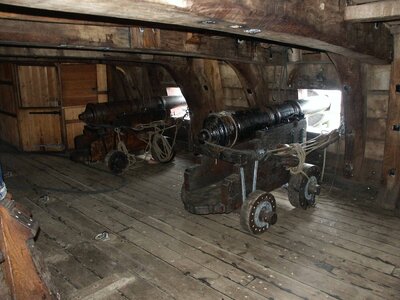
Notice the substantial difference between the rigging on these two cannons which are right next to each other!
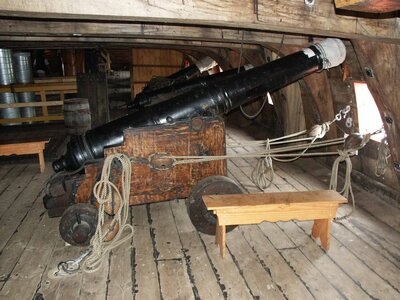
Then a third example which offers at least some semblance to the cannon furthest away in the top picture ...
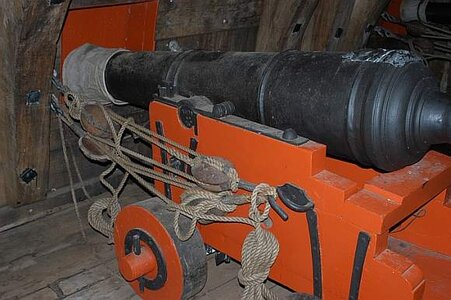
And then a fourth example which even has the gun carriage painted red as opposed to the others which all feature a natural wooden colour.
So it is very clear that even on the Lelystadt replica of the Batavia there is absolutely no cohesive line of thought that is followed. Thus, trying to pinpoint a definitive layout on my model is just ludicrous. I have therefore decided to opt for a layout which will be the most visually pleasing to me and one - which in my opinion - looks the neatest and most impressive.
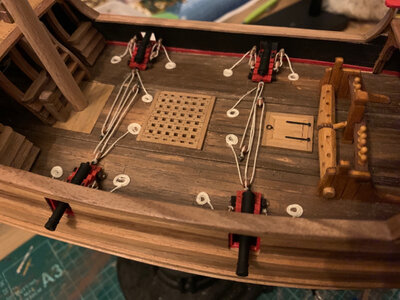
This is thus the layout I will follow as on the Duyfken of Hans Groenenberg and Bouwmuis (Martin). This means that I will be making rope coils until they come out of my ears, but hey ... the rigging on the Batavia just looks like a crow's nest to me!
At the same time I want to thank everyone for taking out the time to follow along, comment and offer advice on the cannon-rigging. @Steef66 I want to thank Stephan in particular - you are absolutely right in your summary of how the cannons should be rigged. I am thus knowingly applying my own interpretation here, but I am doing so because it is just visually more appealing to me.
By the way - further still on the topic of cannons: In Lelystadt there is also this example of a three-wheeled Dutch cannon!
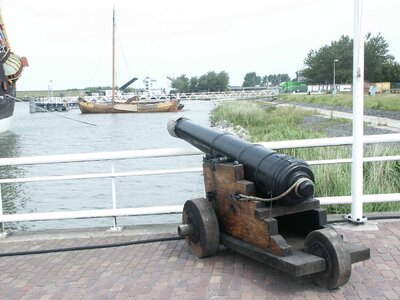
This layout is what I will be using on my next build of a Dutch ship by Kolderstok! Nudge ... nudge ... wink ... wink ...


Notice the substantial difference between the rigging on these two cannons which are right next to each other!

Then a third example which offers at least some semblance to the cannon furthest away in the top picture ...

And then a fourth example which even has the gun carriage painted red as opposed to the others which all feature a natural wooden colour.
So it is very clear that even on the Lelystadt replica of the Batavia there is absolutely no cohesive line of thought that is followed. Thus, trying to pinpoint a definitive layout on my model is just ludicrous. I have therefore decided to opt for a layout which will be the most visually pleasing to me and one - which in my opinion - looks the neatest and most impressive.

This is thus the layout I will follow as on the Duyfken of Hans Groenenberg and Bouwmuis (Martin). This means that I will be making rope coils until they come out of my ears, but hey ... the rigging on the Batavia just looks like a crow's nest to me!
At the same time I want to thank everyone for taking out the time to follow along, comment and offer advice on the cannon-rigging. @Steef66 I want to thank Stephan in particular - you are absolutely right in your summary of how the cannons should be rigged. I am thus knowingly applying my own interpretation here, but I am doing so because it is just visually more appealing to me.
By the way - further still on the topic of cannons: In Lelystadt there is also this example of a three-wheeled Dutch cannon!

This layout is what I will be using on my next build of a Dutch ship by Kolderstok! Nudge ... nudge ... wink ... wink ...
I have been told by a writer and historian of British and French gun ships that the captain had the latitude and did have things painted in the colors of his choice. I cannot verify that or if the British Admiralty tried to standardize such things. I wonder how accurate present day rigging for display of naval guns is . . . maybe for looks and not precision. I agree with models being presented as the builder finds them most pleasing unless the full mission is a level of accuracy upon which provinence can be shown. I am sure that your direction will be outstanding. Rich (PT -2)I gave the cannon-rigging some more thought and actually realized that most of the discussions centered around the rigging of the Duyfken - and not necessarily that of the Batavia as donor-ship. While I do realize that the Duyfken was brought into the equation because of the lack of space that I have available on the deck, it would, nevertheless, be really interesting to see how the cannons on the Batavia were rigged.
View attachment 256777
Notice the substantial difference between the rigging on these two cannons which are right next to each other!
View attachment 256778
Then a third example which offers at least some semblance to the cannon furthest away in the top picture ...
View attachment 256779
And then a fourth example which even has the gun carriage painted red as opposed to the others which all feature a natural wooden colour.
So it is very clear that even on the Lelystadt replica of the Batavia there is absolutely no cohesive line of thought that is followed. Thus, trying to pinpoint a definitive layout on my model is just ludicrous. I have therefore decided to opt for a layout which will be the most visually pleasing to me and one - which in my opinion - looks the neatest and most impressive.
View attachment 256785
This is thus the layout I will follow as on the Duyfken of Hans Groenenberg and Bouwmuis (Martin). This means that I will be making rope coils until they come out of my ears, but hey ... the rigging on the Batavia just looks like a crow's nest to me!
At the same time I want to thank everyone for taking out the time to follow along, comment and offer advice on the cannon-rigging. @Steef66 I want to thank Stephan in particular - you are absolutely right in your summary of how the cannons should be rigged. I am thus knowingly applying my own interpretation here, but I am doing so because it is just visually more appealing to me.
By the way - further still on the topic of cannons: In Lelystadt there is also this example of a three-wheeled Dutch cannon!
View attachment 256786
This layout is what I will be using on my next build of a Dutch ship by Kolderstok! Nudge ... nudge ... wink ... wink ...

- Joined
- Aug 8, 2019
- Messages
- 5,484
- Points
- 738

Yes that was a reason too.was due to the amount of splinters created if a boat was hit by a cannon ball.
Heinrich like I said you are the captain. I'm sure the result will be outstanding
- Joined
- Jan 9, 2020
- Messages
- 10,534
- Points
- 938

@PT-2 Hi Rich. No issues at the moment except that patience is required.
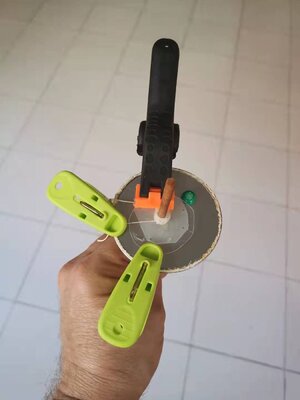
My version of a rope-coiling machine. It may not look like much, but it does get the job done.
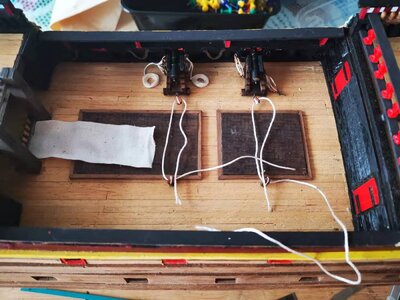
Cannon-rigging in process. Believe me - it is going to look very different when all is done, cleaned up and the lifeboat installed.

My version of a rope-coiling machine. It may not look like much, but it does get the job done.

Cannon-rigging in process. Believe me - it is going to look very different when all is done, cleaned up and the lifeboat installed.
Oops…I had just seen your pics and just assumed the following pics were your ship. You can do it!@Dean62 Hi Dean! Thank you for the kind reply. The execution on Hans Groeneberg's Duyfken does indeed look great! But ... now yours truly still have to execute it on the Haarlem so that it looks like the rigging on the Duyfken!
Looking good… your ship that is.@PT-2 Hi Rich. No issues at the moment except that patience is required.
View attachment 256983
My version of a rope-coiling machine. It may not look like much, but it does get the job done.
View attachment 256984
Cannon-rigging in process. Believe me - it is going to look very different when all is done, cleaned up and the lifeboat installed.
For me it is beyond patience at the moment but continued for the long run or should I say voyage? It is looking well tended to. RIch@PT-2 Hi Rich. No issues at the moment except that patience is required.
View attachment 256983
My version of a rope-coiling machine. It may not look like much, but it does get the job done.
View attachment 256984
Cannon-rigging in process. Believe me - it is going to look very different when all is done, cleaned up and the lifeboat installed.
- Joined
- Jan 9, 2020
- Messages
- 10,534
- Points
- 938

Thanks Dean. Focus ... focus ...Looking good… your ship that is.
- Joined
- Jan 9, 2020
- Messages
- 10,534
- Points
- 938

@PT-2 Rich, like my good friend, Koos, on Modelbouwforum always says: "It keeps him off the street!" You will also notice that between my blocks on the side of the carriage, the connection is via a double rope - not just the single one.For me it is beyond patience at the moment but continued for the long run or should I say voyage? It is looking well tended to. RIch
Kurt Konrath
Kurt Konrath
- Joined
- Jan 9, 2020
- Messages
- 10,534
- Points
- 938

Well don't get too tied up in that job, that you can't teach later....



Coils???? That sounds like at the end of all our exploring and wandering we end up where we started and know it for the first time. Hummmm . . . . . RichWell don't get too tied up in that job, that you can't teach later....

